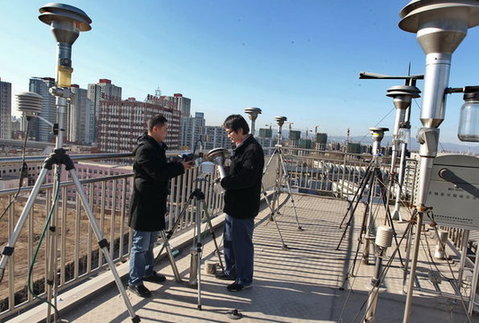China pays for PM2.5 monitoring, U.S. biz gains
 0 Comment(s)
0 Comment(s) Print
Print E-mail Xinhua, March 5, 2012
E-mail Xinhua, March 5, 2012
Beijing plans to invest at least 40 million yuan (6.35 million U.S. dollars) in 2012 in buying PM2.5 monitoring instruments, which will be most likely from U.S-based companies, a senior environmental protection official said Sunday.
|
|
|
China National Environment Monitor Center (CNEMC) workers inspect PM2.5 - airborne pollutants smaller than 2.5 microns in diameter - monitoring equipment in Beijing on Jan 4, 2012. [CFP] |
His words came days after the State Council, or the cabinet, passed Wednesday revised air quality standards that include indices for ozone and PM2.5, tiny airborne particles of 2.5 microns or less -- small enough to bore deeply into the lungs and even pass into the bloodstream.
The new standards stress the protection of human health as a primary objective.
It will remove the inconsistency between existing air quality results and public sentiment, which counts a lot in boosting the government's credibility and international image, Wu Xiaoqing, vice minister of Environmental Protection, said.
"Some 1,500 monitoring sites will be built nationwide by 2015. Initial investment will reach 2 billion yuan, and annual expenditure stands at 100 million yuan," Wu spoke at a press briefing Friday of China's air quality.
Wu said the new standards will be extended to all Chinese cities by 2015, and Jan. 1, 2016, is the deadline for the implementation throughout the nation.
This year, the government decided to monitor PM2.5 in four municipalities, 27 provincial capitals, as well as three key regions -- the eastern Yangtze River Delta, the southern Pearl River Delta and the northern Beijing-Tianjin-Hebei area.
Several months ago, however, PM2.5 was still an academic terminology shared only by a tiny science community and few expected such a concrete action to be made so soon.
PM10 was previously used as part of the country's air quality standards before being replaced by the PM2.5 index, which measures finer particles that are considered more hazardous to health than larger ones.
A fierce online debate over whether the government should release regularly PM2.5 statistics was triggered at the end of 2011 by a discrepancy in the air quality monitoring results released by Beijing's weather forecasting station and the U.S. Embassy in Beijing.
While the Beijing weather forecasting station said air pollution was minor, the embassy's results labeled Beijing's air quality as "hazardous" or "dangerous." Both sources defended their stances by saying that the difference was not manipulated, but a result of different measuring systems being used.
In response to public outcry, Beijing began releasing hourly PM2.5 readings on Jan. 21. But the two sides' readings still diverged, as the city's official data usually fell below the U.S. Embassy's figure.
The U.S. Embassy explains on its official website why an air quality monitor to measure PM2.5 particles has been set up on the embassy compound.
"This monitor is a resource for the health of the Mission community. Citywide analysis cannot be done, however, on data from a lone machine," the statement says. < The U.S. State Department rules that employees, who are for service in foreign areas where conditions of environment differ substantially from those in the continental United States, would be additionally compensated post hardship differential allowance as "a recruitment and retention incentive."
The current compensation policy indicates that U.S. staff in both Beijing and Shanghai receive 15 percent of basic compensation as post hardship differential allowance, while employees in Nanjing, Shenyang and Wuhan receive 30 percent.
Yu Jianhua, an air quality expert with the Beijing Environmental Protection Bureau, said in a local radio interview that selecting a proper air quality monitoring site was critical for accurate data collection.
He said the site should be 50 meters away from sources of pollution, such as places that emit automobile exhaust or burn coal. The requirement is also in accord with international general practice.
He also said monitoring sites should not be located in isolated places, nor in the most polluted points.
The U.S. Embassy, however, has placed its monitoring instrument 15 meters away from the bustling street.
Beijing plans to equip the current 27 PM10 monitoring stations with PM2.5 monitoring instruments, and establish a total of 36 stations in both the city proper and its outskirts by the end of 2012.
"We now have facilities sufficient for six substations. We will strive to finish establishing them in the first half of the year. The new station will release hourly PM2.5 data," Yu said.
The equipment and technologies that China is using to monitor PM2.5 are mainly from foreign countries, said Wen Xiangcai, a researcher at the China National Environmental Monitoring Center (CNEMC).
Wen, also a member of the National Committee of the Chinese People's Political Consultative Conference, said China should speed up research and development on air quality monitoring equipment in line with rising demand after the country puts stricter air quality standards in place.
World leading PM2.5 monitor producers include Thermo Fisher Scientific, Met One Instruments and Automated Precision Inc., all from the U.S, and Australian Monitor and Echotech from Australia.
Products from foreign companies have grabbed more than 70 percent of the Chinese market, said Wang Yuesi, a researcher with the Chinese Academy of Sciences (CAS) Institute of Atmospheric Physics.
Experts say it's too soon to start releasing data as relevant technological specifications have yet to be laid down and monitoring methods have not been chosen.
"It usually takes one year for researchers to compare and contrast different automated continuous monitoring methods with the regulatory filter-based and manual air pollution collection data, adjust instruments, and choose to apply the most appropriate ones," the CAS researcher said.
Wang said data obtained through different methods should be collected at different locations and in different seasons in the same city before a conclusion can be reached.
The CNEMC has began comparative analyses since mid-January.







Go to Forum >>0 Comment(s)